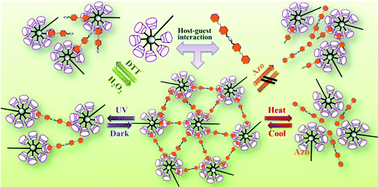Fabrication of multi-stimuli responsive supramolecular hydrogels based on host–guest inclusion complexation of a tadpole-shaped cyclodextrin derivative with the azobenzene dimer†
Abstract
Motivated by the demand for high-performance soft materials for applications in catalysis, drug delivery and biomedical materials, the development of smart hydrogels that possess both biocompatibility and stimulus responsiveness has been highly desirable. Here, we demonstrated a facile method to construct a multi-responsive supramolecular hydrogel by the formation of host–guest complexes between the tadpole-shaped PEG-POSS-(CD)7 polymer and Azo-SS-Azo dimer. Incorporation of rigid POSS units furnished supramolecular cross-linked networks with high mechanical strength. The reversible gel–sol phase transition of supramolecular hydrogels could be induced by temperature, light and redox while the Azo derivatives could induce a quick gel–sol transition. These novel supramolecular hydrogels also possessed a favorable self-healing ability and better biocompatibility, which endowed the smart hydrogels with potential practical and real-life applications that will be beneficial for further development of more intelligent materials with desired functionalities.



 Please wait while we load your content...
Please wait while we load your content...